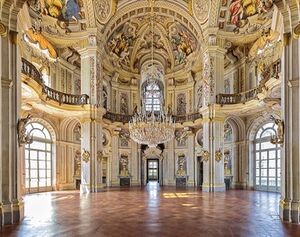Palazzo sulle Bianche Pianure
| Palace on the White Plains | |
|---|---|
Palazzo sulle Bianche Pianure | |
| General information | |
| Type | Palace |
| Architectural style | Baroque |
| Location | Trossera |
| Country | Aciria |
| Construction started | 1712 |
| Renovated | Multiple times, most recently in 2008 |
| Owner | Emperor of Aciria |
| Known for | Residence of the Imperial Family of Aciria |
Palazzo sulle Bianche Pianure, or the Palace on the White Plains is the official residence and one of the major royal palaces of the Emperor of Aciria, but the current Emperor Ignazio I and Empress Luciana use the Ritiro Imperiale as their usual residence. The palace is on the outskirts of Trossera surrounded by the Giovanni Park. The offices of the Emperor and his Imperial Family alongside with the Imperial Court of Aciria are here.
The palace was designed and built by Lucredo Vitalentini after First Speaker Carusso commissioned it as the official estate of the First speaker. The name of the palace was given by Vitalentini who was given free reign over the location of the palace other than making sure it's close enough to Trossera. Vitalentini decided to construct it right outside of Trossera due to the sudden snowfall that followed his departure from Trossera, and named it after the inspiring sight of the white plains. Following the establishment of the Empire of Aciria, Giovanni I seized the property for the Imperial Seat and established it as the official Imperial Residence. In 1800 an expansion of the palace was ordered, which eventually doubled the size of the estate. Following the ascension of Ignazio I, the seldom used left wing of the estate was turned into an art museum available to the general public as a tourist attraction.
History
The land the palace was constructed on had little notable construction prior, with the land being primarily used for farmland.
Republican era
Prior to the construction of the palace, the First Speaker of the Republic had no official residence. The conversation over a possible official residence for the First Speaker during their term in office was started in 1708 following the death of First Speaker Orani after his home in Trossera was overwhelmed by the commoners, and in 1711 the People's Senate designated money for the construction of a residence for the First Speaker. Architect-engineer Lucredo Vitalentini was given the responsibility of designing and constructing the residence, with even given free reign of the construction site, with the only requirement being it being in close vicinity of Trossera. After designating the location for the residence, Vitalentini drafted up the designs for the residence based on the Castra Sarcyra following his recent visit to Montverde to study the Caphirian Baroque architectural style.

The original drafts for the palace were turned down due to the wave of republican fervor and the desire to distance the republic from its imperial heritage. The following two drafts also were turned down due to budgetary constraints, and finally in 1712 the fourth draft was accepted and the construction of the Palace was started. After the initial construction efforts, Vitalentini suggested creating a park in the surrounding area for public use but the idea was not executed.
Imperial era
The palace had been used as the residence of the First Speaker for 50 years by the time Giovanni I seized power from the senate and the First Speaker and established the Empire. To further legitimize his rule, he designated the former residence of the First Speaker as the official residence of the Imperial Family. Giovanni thought that the palace wasn't grand enough for an Emperor compared to the estates of those in Caphiria and Urcea, which is why Giovanni ordered the first expansion of the palace in 1800. The construction used valuable and prestigious materials and doubled the size of the estate, and the drain of the construction was so big on the imperial coffers the construction near bankrupted the new empire. After 1800, three other expansions have been ordered in 1855, 1901 and 1959, with even more renovations for various reasons over its existence.
Description
Gallery
This article is considered abandoned lore either because its creator has changed projects or has left the community. Accordingly, it is not only non-canon but it is also eligible for salvage pending approval from an administrator.
|